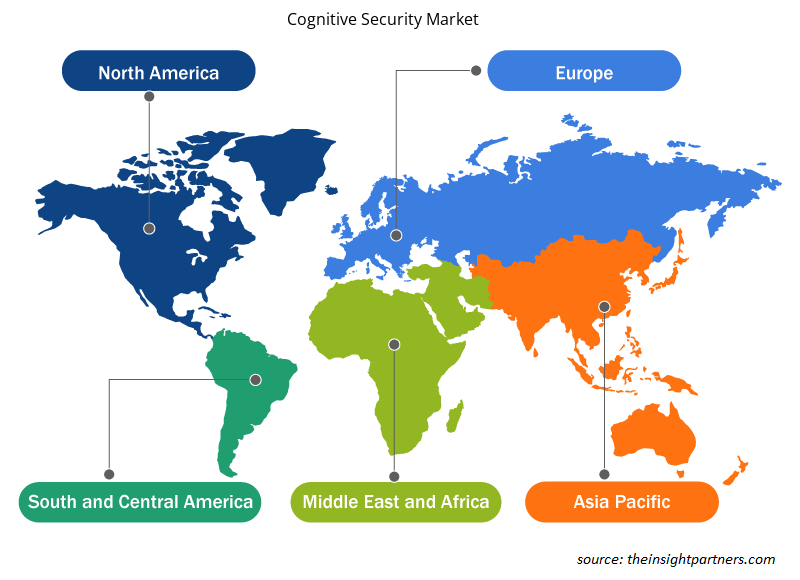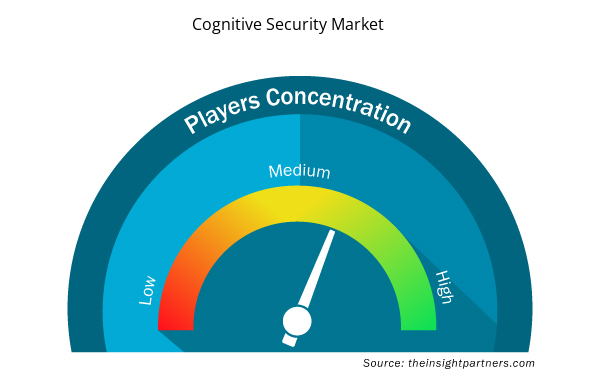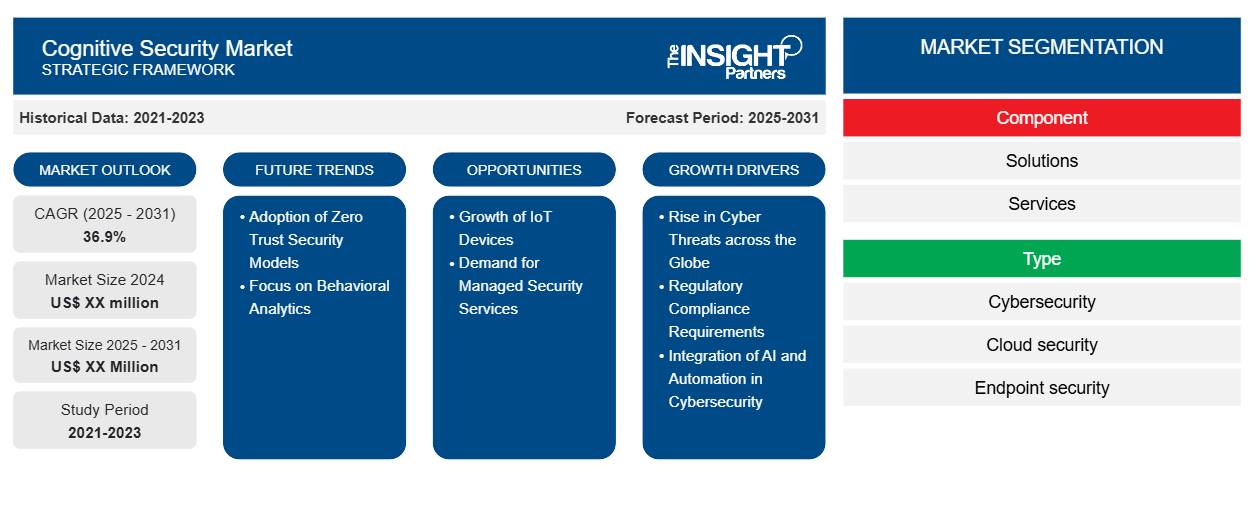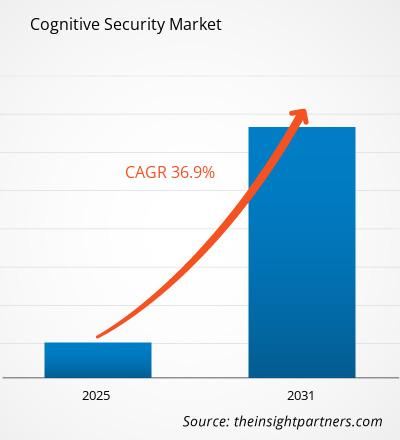Le marché de la sécurité cognitive devrait enregistrer un TCAC de 36,9 % de 2023 à 2031, avec une taille de marché passant de XX millions USD en 2023 à XX millions USD d'ici 2031.
Le rapport est segmenté par Composant (Solutions, Services) ; Type ( Cybersécurité , Sécurité du cloud, Sécurité des terminaux, Sécurité des applications, Sécurité du réseau, Autres) ; Application (Intelligence sur les menaces, Gestion automatisée de la conformité, Détection des anomalies et atténuation des risques, Autres) ; Secteur vertical ( BFSI , Informatique et télécommunications, Aérospatiale et défense, Fabrication, Vente au détail, Santé, Gouvernement, Autres). L'analyse globale est ensuite décomposée au niveau régional et par principaux pays. Le rapport offre la valeur en USD pour l'analyse et les segments ci-dessus
Objectif du rapport
Le rapport Cognitive Security Market de The Insight Partners vise à décrire le paysage actuel et la croissance future, les principaux facteurs moteurs, les défis et les opportunités. Cela fournira des informations à diverses parties prenantes commerciales, telles que :
- Fournisseurs/fabricants de technologie : pour comprendre l’évolution de la dynamique du marché et connaître les opportunités de croissance potentielles, leur permettant de prendre des décisions stratégiques éclairées.
- Investisseurs : Effectuer une analyse complète des tendances concernant le taux de croissance du marché, les projections financières du marché et les opportunités qui existent tout au long de la chaîne de valeur.
- Organismes de réglementation : Réglementer les politiques et surveiller les activités du marché dans le but de minimiser les abus, de préserver la confiance des investisseurs et de maintenir l’intégrité et la stabilité du marché.
Segmentation du marché de la sécurité cognitive
Composant
- Solutions
- Services
Taper
- Cybersécurité
- Sécurité du cloud
- Sécurité des terminaux
- Sécurité des applications
- Sécurité du réseau
- Autres
Application
- Renseignement sur les menaces
- Gestion automatisée de la conformité
- Détection des anomalies et atténuation des risques
- Autres
Secteur d'activité vertical
- BFSI
- Informatique et télécommunications
- Aérospatiale et Défense
- Fabrication
- Vente au détail
- Soins de santé
- Gouvernement
- Autres
Secteur d'activité vertical
- BFSI
- Informatique et télécommunications
- Aérospatiale et Défense
- Fabrication
- Vente au détail
- Soins de santé
- Gouvernement
- Autres
Personnalisez ce rapport en fonction de vos besoins
Vous bénéficierez d'une personnalisation gratuite de n'importe quel rapport, y compris de certaines parties de ce rapport, d'une analyse au niveau des pays, d'un pack de données Excel, ainsi que de superbes offres et réductions pour les start-ups et les universités.
- Obtenez les principales tendances clés du marché de ce rapport.Cet échantillon GRATUIT comprendra une analyse de données, allant des tendances du marché aux estimations et prévisions.
Facteurs de croissance du marché de la sécurité cognitive
- Augmentation des cybermenaces à travers le monde : La fréquence et la sophistication croissantes des cybermenaces sont des facteurs importants de croissance du marché de la sécurité cognitive. Les entreprises étant confrontées à des menaces persistantes avancées, à des attaques de ransomware et à des violations de données, il est urgent de renforcer leurs mesures de sécurité. La sécurité cognitive, qui s'appuie sur l'intelligence artificielle et l'apprentissage automatique, permet une détection et une réponse proactives aux menaces, permettant aux entreprises d'identifier les vulnérabilités en temps réel. Cette prise de conscience accrue des risques liés à la cybersécurité stimule la demande de solutions de sécurité cognitive, ce qui stimule la croissance du marché, les entreprises accordant la priorité à la protection de leurs actifs numériques.
- Exigences de conformité réglementaire : les cadres réglementaires et les exigences de conformité plus stricts dans tous les secteurs stimulent la croissance du marché de la sécurité cognitive. Les organisations doivent se conformer à des réglementations telles que GDPR, HIPAA et PCI DSS, qui imposent des mesures de protection des données robustes. Les solutions de sécurité cognitive aident les entreprises à automatiser les processus de conformité en surveillant l'accès aux données, en détectant les anomalies et en générant des pistes d'audit. Alors que les entreprises s'efforcent de répondre à ces exigences réglementaires tout en garantissant la sécurité des données, l'adoption de technologies de sécurité cognitive devient de plus en plus critique.
- Intégration de l’IA et de l’automatisation dans la cybersécurité : L’intégration de l’intelligence artificielle (IA) et de l’automatisation dans la cybersécurité est un moteur essentiel du marché de la sécurité cognitive. Les mesures de sécurité traditionnelles ne parviennent souvent pas à faire face aux complexités des menaces modernes. Les systèmes de sécurité cognitive utilisent des algorithmes d’IA pour analyser de vastes quantités de données, identifier des modèles et prédire les attaques potentielles. Cette capacité permet aux organisations de réagir rapidement aux menaces émergentes, faisant de la sécurité cognitive une solution attrayante pour les entreprises qui cherchent à améliorer leur posture de cybersécurité et leur efficacité opérationnelle.
Tendances futures du marché de la sécurité cognitive
- Adoption de modèles de sécurité Zero Trust : l'adoption de modèles de sécurité Zero Trust est une tendance majeure sur le marché de la sécurité cognitive. Les organisations reconnaissent de plus en plus que la sécurité traditionnelle basée sur le périmètre est insuffisante dans le paysage des menaces actuel. Les principes Zero Trust mettent l'accent sur la vérification continue et les contrôles d'accès stricts, quel que soit l'emplacement de l'utilisateur. Les solutions de sécurité cognitive s'alignent bien sur cette tendance en fournissant des analyses en temps réel et des renseignements sur les menaces, permettant aux organisations de mettre en œuvre efficacement des cadres Zero Trust. Cette évolution stimule la demande de technologies de sécurité cognitive qui prennent en charge une vérification d'identité et une gestion des accès améliorées.
- Focus sur l’analyse comportementale : on observe une tendance croissante à intégrer l’analyse comportementale dans les solutions de sécurité cognitive. En analysant les schémas de comportement des utilisateurs, les systèmes de sécurité cognitive peuvent identifier les anomalies qui peuvent indiquer des failles de sécurité potentielles ou des menaces internes. Cette approche proactive permet aux organisations de détecter et de répondre aux menaces plus efficacement. Alors que les entreprises donnent la priorité aux mesures de sécurité centrées sur l’utilisateur, l’intégration de l’analyse comportementale dans les solutions de sécurité cognitive devrait prendre de l’ampleur, stimulant l’innovation et la croissance du marché alors que les organisations cherchent à améliorer leur posture de sécurité globale.
Opportunités du marché de la sécurité cognitive
- Croissance des appareils IoT : La prolifération des appareils IoT représente une opportunité considérable pour le marché de la sécurité cognitive. À mesure que de plus en plus d’appareils se connectent aux réseaux, ils deviennent des points d’entrée potentiels pour les cybermenaces. Les solutions de sécurité cognitive peuvent offrir une protection complète en analysant les données de ces appareils, en détectant les anomalies et en mettant en œuvre des mesures de sécurité en temps réel. Les entreprises qui développent des technologies de sécurité cognitive adaptées aux environnements IoT peuvent conquérir un segment croissant du marché, en relevant les défis uniques posés par les appareils interconnectés.
- Demande de services de sécurité gérés : la complexité croissante des menaces de cybersécurité a entraîné une demande croissante de services de sécurité gérés (MSS). Les organisations externalisent leurs besoins en matière de sécurité auprès de fournisseurs spécialisés qui proposent des solutions de sécurité cognitive. Cette tendance crée des opportunités pour les fournisseurs de sécurité cognitive de s'associer aux MSSP et de fournir des capacités avancées de détection et de réponse aux menaces. En exploitant les technologies cognitives, les services de sécurité gérés peuvent améliorer leurs offres, en offrant une protection et une conformité améliorées aux entreprises, et en élargissant ainsi leur portée sur le marché.
Aperçu régional du marché de la sécurité cognitive
Les tendances et facteurs régionaux influençant le marché de la sécurité cognitive tout au long de la période de prévision ont été expliqués en détail par les analystes d’Insight Partners. Cette section traite également des segments et de la géographie du marché de la sécurité cognitive en Amérique du Nord, en Europe, en Asie-Pacifique, au Moyen-Orient et en Afrique, ainsi qu’en Amérique du Sud et en Amérique centrale.

- Obtenez les données régionales spécifiques au marché de la sécurité cognitive
Portée du rapport sur le marché de la sécurité cognitive
| Attribut de rapport | Détails |
|---|---|
| Taille du marché en 2023 | XX millions de dollars américains |
| Taille du marché d'ici 2031 | XX millions de dollars américains |
| Taux de croissance annuel composé mondial (2023-2031) | 36,9% |
| Données historiques | 2021-2022 |
| Période de prévision | 2024-2031 |
| Segments couverts | Par composant
|
| Régions et pays couverts | Amérique du Nord
|
| Leaders du marché et profils d'entreprises clés |
|
Densité des acteurs du marché de la sécurité cognitive : comprendre son impact sur la dynamique des entreprises
Le marché de la sécurité cognitive connaît une croissance rapide, tirée par la demande croissante des utilisateurs finaux en raison de facteurs tels que l'évolution des préférences des consommateurs, les avancées technologiques et une plus grande sensibilisation aux avantages du produit. À mesure que la demande augmente, les entreprises élargissent leurs offres, innovent pour répondre aux besoins des consommateurs et capitalisent sur les tendances émergentes, ce qui alimente davantage la croissance du marché.
La densité des acteurs du marché fait référence à la répartition des entreprises ou des sociétés opérant sur un marché ou un secteur particulier. Elle indique le nombre de concurrents (acteurs du marché) présents sur un marché donné par rapport à sa taille ou à sa valeur marchande totale.
Les principales entreprises opérant sur le marché de la sécurité cognitive sont :
- Accenture
- BlackBerry Limitée
- Cisco Systems, Inc.
- Instinct profond
- Pont de Haute Technologie SA
Avis de non-responsabilité : les sociétés répertoriées ci-dessus ne sont pas classées dans un ordre particulier.

- Obtenez un aperçu des principaux acteurs du marché de la sécurité cognitive
Principaux arguments de vente
- Couverture complète : Le rapport couvre de manière exhaustive l’analyse des produits, des services, des types et des utilisateurs finaux du marché de la sécurité cognitive, offrant un paysage holistique.
- Analyse d’experts : Le rapport est compilé sur la base d’une compréhension approfondie des experts et analystes du secteur.
- Informations à jour : Le rapport garantit la pertinence commerciale en raison de sa couverture des informations récentes et des tendances des données.
- Options de personnalisation : ce rapport peut être personnalisé pour répondre aux exigences spécifiques du client et s'adapter parfaitement aux stratégies commerciales.
Le rapport de recherche sur le marché de la sécurité cognitive peut donc aider à ouvrir la voie au décodage et à la compréhension du scénario de l’industrie et des perspectives de croissance. Bien qu’il puisse y avoir quelques préoccupations valables, les avantages globaux de ce rapport ont tendance à l’emporter sur les inconvénients.
- Analyse historique (2 ans), année de base, prévision (7 ans) avec TCAC
- Analyse PEST et SWO
- Taille du marché Valeur / Volume - Mondial, Régional, Pays
- Industrie et paysage concurrentiel
- Ensemble de données Excel



Report Coverage
Revenue forecast, Company Analysis, Industry landscape, Growth factors, and Trends

Segment Covered
This text is related
to segments covered.

Regional Scope
North America, Europe, Asia Pacific, Middle East & Africa, South & Central America

Country Scope
This text is related
to country scope.
Questions fréquemment posées
Some of the customization options available based on the request are an additional 3-5 company profiles and country-specific analysis of 3-5 countries of your choice. Customizations are to be requested/discussed before making final order confirmation# as our team would review the same and check the feasibility
The report can be delivered in PDF/PPT format; we can also share excel dataset based on the request
Cloud-based security solutions to play a significant role in the global cognitive security market in the coming years
Growing Cyber-threat and AI and Machine Learning advancements are the major factors driving the cognitive security market
The Cognitive Security Market is estimated to witness a CAGR of 36.9% from 2023 to 2031
Trends and growth analysis reports related to Technology, Media and Telecommunications : READ MORE..
- Accenture
- BlackBerry Limited
- Cisco Systems, Inc.
- Deep Instinct
- High-Tech Bridge SA
- IBM
- LogRhythm, Inc.
- McAfee, LLC
- Securonix
- SparkCognition
The Insight Partners performs research in 4 major stages: Data Collection & Secondary Research, Primary Research, Data Analysis and Data Triangulation & Final Review.
- Data Collection and Secondary Research:
As a market research and consulting firm operating from a decade, we have published and advised several client across the globe. First step for any study will start with an assessment of currently available data and insights from existing reports. Further, historical and current market information is collected from Investor Presentations, Annual Reports, SEC Filings, etc., and other information related to company’s performance and market positioning are gathered from Paid Databases (Factiva, Hoovers, and Reuters) and various other publications available in public domain.
Several associations trade associates, technical forums, institutes, societies and organization are accessed to gain technical as well as market related insights through their publications such as research papers, blogs and press releases related to the studies are referred to get cues about the market. Further, white papers, journals, magazines, and other news articles published in last 3 years are scrutinized and analyzed to understand the current market trends.
- Primary Research:
The primarily interview analysis comprise of data obtained from industry participants interview and answers to survey questions gathered by in-house primary team.
For primary research, interviews are conducted with industry experts/CEOs/Marketing Managers/VPs/Subject Matter Experts from both demand and supply side to get a 360-degree view of the market. The primary team conducts several interviews based on the complexity of the markets to understand the various market trends and dynamics which makes research more credible and precise.
A typical research interview fulfils the following functions:
- Provides first-hand information on the market size, market trends, growth trends, competitive landscape, and outlook
- Validates and strengthens in-house secondary research findings
- Develops the analysis team’s expertise and market understanding
Primary research involves email interactions and telephone interviews for each market, category, segment, and sub-segment across geographies. The participants who typically take part in such a process include, but are not limited to:
- Industry participants: VPs, business development managers, market intelligence managers and national sales managers
- Outside experts: Valuation experts, research analysts and key opinion leaders specializing in the electronics and semiconductor industry.
Below is the breakup of our primary respondents by company, designation, and region:

Once we receive the confirmation from primary research sources or primary respondents, we finalize the base year market estimation and forecast the data as per the macroeconomic and microeconomic factors assessed during data collection.
- Data Analysis:
Once data is validated through both secondary as well as primary respondents, we finalize the market estimations by hypothesis formulation and factor analysis at regional and country level.
- Macro-Economic Factor Analysis:
We analyse macroeconomic indicators such the gross domestic product (GDP), increase in the demand for goods and services across industries, technological advancement, regional economic growth, governmental policies, the influence of COVID-19, PEST analysis, and other aspects. This analysis aids in setting benchmarks for various nations/regions and approximating market splits. Additionally, the general trend of the aforementioned components aid in determining the market's development possibilities.
- Country Level Data:
Various factors that are especially aligned to the country are taken into account to determine the market size for a certain area and country, including the presence of vendors, such as headquarters and offices, the country's GDP, demand patterns, and industry growth. To comprehend the market dynamics for the nation, a number of growth variables, inhibitors, application areas, and current market trends are researched. The aforementioned elements aid in determining the country's overall market's growth potential.
- Company Profile:
The “Table of Contents” is formulated by listing and analyzing more than 25 - 30 companies operating in the market ecosystem across geographies. However, we profile only 10 companies as a standard practice in our syndicate reports. These 10 companies comprise leading, emerging, and regional players. Nonetheless, our analysis is not restricted to the 10 listed companies, we also analyze other companies present in the market to develop a holistic view and understand the prevailing trends. The “Company Profiles” section in the report covers key facts, business description, products & services, financial information, SWOT analysis, and key developments. The financial information presented is extracted from the annual reports and official documents of the publicly listed companies. Upon collecting the information for the sections of respective companies, we verify them via various primary sources and then compile the data in respective company profiles. The company level information helps us in deriving the base number as well as in forecasting the market size.
- Developing Base Number:
Aggregation of sales statistics (2020-2022) and macro-economic factor, and other secondary and primary research insights are utilized to arrive at base number and related market shares for 2022. The data gaps are identified in this step and relevant market data is analyzed, collected from paid primary interviews or databases. On finalizing the base year market size, forecasts are developed on the basis of macro-economic, industry and market growth factors and company level analysis.
- Data Triangulation and Final Review:
The market findings and base year market size calculations are validated from supply as well as demand side. Demand side validations are based on macro-economic factor analysis and benchmarks for respective regions and countries. In case of supply side validations, revenues of major companies are estimated (in case not available) based on industry benchmark, approximate number of employees, product portfolio, and primary interviews revenues are gathered. Further revenue from target product/service segment is assessed to avoid overshooting of market statistics. In case of heavy deviations between supply and demand side values, all thes steps are repeated to achieve synchronization.
We follow an iterative model, wherein we share our research findings with Subject Matter Experts (SME’s) and Key Opinion Leaders (KOLs) until consensus view of the market is not formulated – this model negates any drastic deviation in the opinions of experts. Only validated and universally acceptable research findings are quoted in our reports.
We have important check points that we use to validate our research findings – which we call – data triangulation, where we validate the information, we generate from secondary sources with primary interviews and then we re-validate with our internal data bases and Subject matter experts. This comprehensive model enables us to deliver high quality, reliable data in shortest possible time.


 Obtenez un échantillon gratuit pour ce rapport
Obtenez un échantillon gratuit pour ce rapport